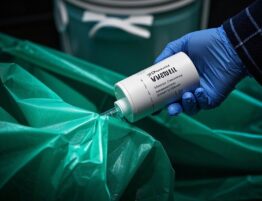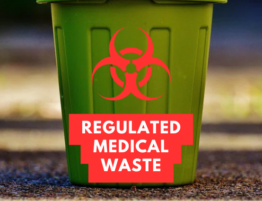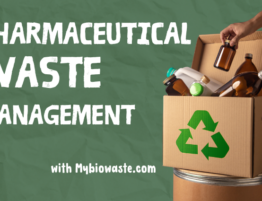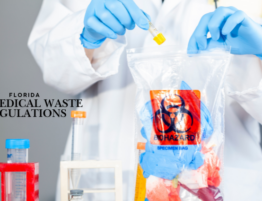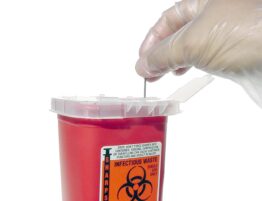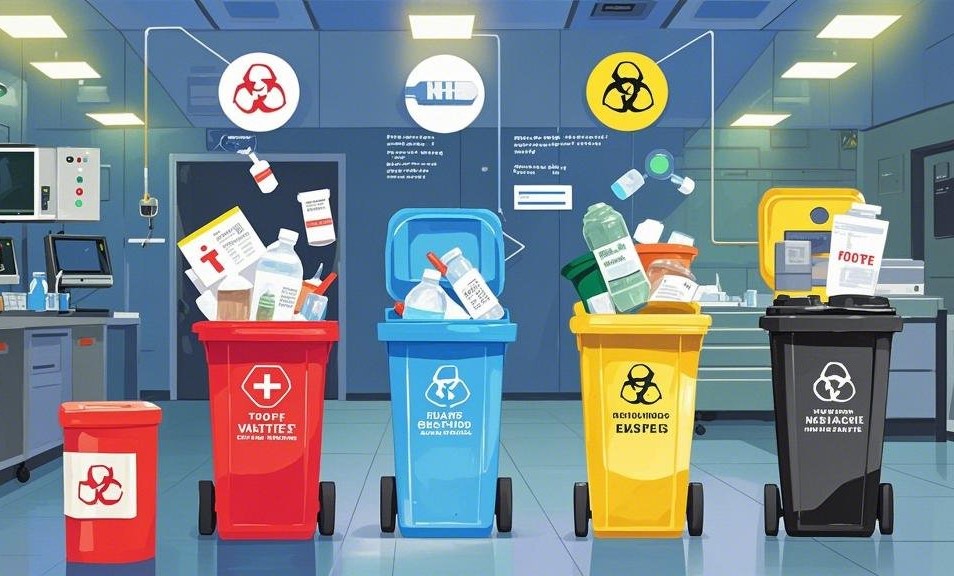
Every year, millions of tons of biomedical waste are generated worldwide. This waste poses serious risks to public health and the environment. From hospitals to research labs, medical facilities produce waste that can be harmful if not managed properly.
Improper disposal of biomedical waste is a huge concern. If not handled correctly, it can spread infections, pollute the environment, and lead to legal penalties. Healthcare facilities that fail to follow proper disposal rules face fines and damage to their reputation.
Understanding and following biomedical waste disposal rules is key for healthcare facilities, waste management companies, and regulatory bodies. Proper disposal ensures public health, protects the environment, and keeps facilities in compliance with the law. In this guide, we’ll cover the categories of biomedical waste, how to properly dispose of it, and the rules to follow.
What is Biomedical Waste? Definition & Importance
Biomedical waste (BMW) is waste that comes from medical, biological, or pharmaceutical activities and can harm living beings or the environment. It is different from regular waste because it can contain dangerous substances like pathogens, chemicals, or sharps.
Common Sources of Biomedical Waste:
- Hospitals: Blood-soaked materials, surgical tools, needles.
- Clinics: Syringes, bandages, used gloves.
- Labs: Petri dishes, used glassware.
- Pharmaceutical Companies: Expired drugs, vaccines.
- Research Facilities: Biohazardous waste, animal parts.
Risks of Improper Disposal:
If biomedical waste is not disposed of properly, it can cause infections, chemical exposure, or environmental pollution. For example, untreated blood waste can carry dangerous viruses like HIV, and chemicals from expired drugs can pollute water supplies.
Classification of Biomedical Waste: Categories & Examples
Biomedical waste is divided into categories to make disposal easier and safer. Here are the main types:
1. Infectious Waste
Waste contaminated with harmful pathogens, like blood-soaked bandages and swabs. Examples:
- Blood-soaked bandages
- Swabs and cultures
2. Pathological Waste
Human tissues, organs, or body parts. These need special care because of the biological risk. Examples:
- Human tissues
- Aborted fetuses
- Body parts
3. Sharps Waste
Sharps waste includes items that can cut or puncture. Improper disposal of sharps can cause injuries and spread infections. Proper Sharps disposal is crucial to prevent harm. Examples include:
- Needles
- Scalpels
- Broken glass
4. Pharmaceutical Waste
Expired or unused medicines that are dangerous if not disposed of correctly. Examples:
- Expired antibiotics
- Vaccine vials
- Over-the-counter drugs
5. Chemical Waste
Hazardous chemicals used in labs or medical procedures. Examples:
- Laboratory solvents
- Disinfectants
- Chemicals used in treatments
6. Radioactive Waste
Waste from nuclear medicine that contains radioactive materials. Examples:
- Contaminated materials from radiotherapy
- Radioactive needles or vials
Segregation Rules: Color-Coded Bins & Best Practices
To avoid contamination, biomedical waste should be separated into different types and placed in color-coded bins. This helps ensure the waste is disposed of safely.
Color-Coding System:
- Yellow: For infectious and pathological waste
- Red: For contaminated plastics, like IV tubes
- Blue/White: For sharps like needles and broken glass
- Black: For non-hazardous waste like regular plastic
Best Practices for Waste Segregation:
- Segregate waste immediately at the point of generation to avoid mixing.
- Use sturdy, leak-proof containers for sharps waste.
- Regularly train staff on the proper way to handle and dispose of medical waste.
- Follow local and international guidelines for disposal to stay compliant.
Collection, Storage, & Transportation Regulations
Biomedical waste must be handled carefully, stored safely, and transported properly to avoid accidents.
Safe Handling Procedures:
- Wear protective clothing, like gloves and masks, when handling waste.
- Make sure all containers are tightly sealed to prevent leaks or spills.
- Segregate waste as soon as it is generated to limit exposure.
Storage Duration Limits:
- Infectious waste should not be stored for more than 48 hours without treatment.
- Waste should be stored in cool, controlled areas to prevent contamination.
Transportation Guidelines:
- Use leak-proof and labeled containers for transport.
- Transporters must use special vehicles designed for biomedical waste to prevent leaks.
Approved Biomedical Waste Treatment & Disposal Methods
Biomedical waste can be treated in several ways, depending on the type of waste. Here are the most common treatment methods:
Incineration
Used for pathological and pharmaceutical waste, incineration burns the waste at high temperatures, turning it into ash. This method effectively destroys harmful bacteria and viruses.
Autoclaving
Autoclaving uses high-pressure steam to sterilize infectious waste like sharps, blood-soaked items, and medical tools. It is eco-friendly and widely used.
Chemical Disinfection
This method is used for liquid waste, like lab chemicals, by neutralizing harmful substances with chemicals.
Microwave Treatment
Microwaves are used to heat and sterilize solid waste, killing any harmful pathogens.
Deep Burial
In some rural areas, deep burial is allowed for certain types of biomedical waste. However, it is not commonly used in urban areas due to environmental concerns.
Sustainable Alternatives
New methods are being developed to reduce the environmental impact of waste disposal, such as waste-to-energy technologies and solar-powered treatment systems.
Compliance & Legal Framework: Avoiding Penalties
There are strict laws around biomedical waste disposal, and failing to follow them can result in heavy penalties. These laws vary by country, but they generally include rules on tracking waste, training staff, and keeping records.
Key Legal Requirements:
- Waste tracking: Keep records of all waste that is disposed of.
- Training: Healthcare staff must be trained regularly on the proper handling and disposal of biomedical waste.
- Environmental Assessments: Regularly evaluate the impact of waste management practices.
Penalties for Non-Compliance:
Failure to follow biomedical waste disposal rules can lead to fines, lawsuits, or even the shutdown of a healthcare facility.
Best Practices for Healthcare Facilities & Waste Management Companies
To stay compliant and ensure safe disposal, healthcare facilities and waste management companies should follow these best practices:
- Train Staff Regularly: Make sure healthcare workers know the rules for handling biomedical waste.
- Minimize Waste: Use strategies to reduce the amount of waste produced in the first place.
- Choose Certified Waste Management Providers: Partner with waste management companies that are certified and follow all regulations.
- Conduct Regular Audits: Regularly review waste disposal practices to ensure compliance and identify any areas for improvement.
Future Trends & Innovations in Biomedical Waste Disposal
The future of biomedical waste disposal is moving towards more efficient and eco-friendly methods. Some of the latest trends include:
Emerging Trends:
- AI & Automation: Smart systems are being used to sort and track medical waste automatically.
- Eco-Friendly Alternatives: New methods like solar-powered waste treatment and waste-to-energy technology are gaining popularity.
- Global Sustainability Efforts: Many countries are working together to create more sustainable solutions for medical waste.
Final Thoughts
Proper biomedical waste disposal is essential for protecting human health, the environment, and staying compliant with the law. Understanding the rules around waste classification, treatment, and transportation is key to ensuring safe and legal disposal.
Stay informed about local and international biomedical waste disposal regulations. Adopt best practices for waste management, explore sustainable disposal methods, and always prioritize safety and compliance in your facility.
FAQs
What is biomedical waste segregation?
Biomedical waste segregation is the process of separating different types of medical waste into specific categories using color-coded bins for safe disposal.
What are the legal consequences of improper biomedical waste disposal?
Improper disposal of biomedical waste can lead to significant fines, lawsuits, and even the closure of healthcare facilities.
How long can biomedical waste be stored before disposal?
Infectious waste should not be stored for more than 48 hours without treatment, while other waste types may have different storage guidelines depending on local regulations.

